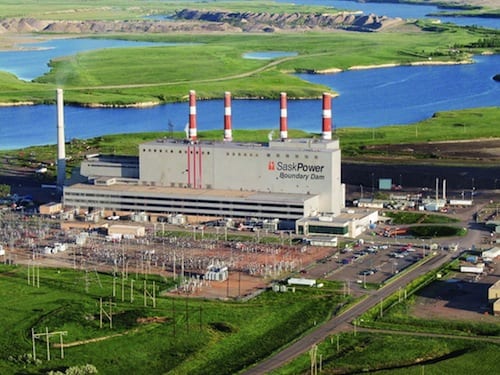When global movers and shakers in the carbon capture and storage (CCS) world gathered for the grand opening of the 110 megawatt (MW) Boundary Dam CCS power station in Saskatchewan Canada, they were in a celebratory mood.
The plant was a “game-changer” proclaimed some, “impressive” said the provincial premier, “a momentous point” said the international Energy Agency, encouraging said an international network of ten pro-CCS environmental groups and “the first commercial-scale CCS project of its kind in the world” boasted the provincial utility, SaskPower.
But despite all the backslapping and credulous media coverage of the event, perhaps more than anything else the Boundary Dam plant illustrates the huge challenges that CCS faces in progressing any further.
SaskPower gets lucky two strikes down
Early last decade SaskPower, the publicly owned utility, began contemplating what it would do to replace its ageing coal generation fleet.
Federal environmental legislation was looming which would require the retirement of coal-plants over 50 years old unless they met new emissions performance standards. For SaskPower this meant the progressive closure of the six small old units of the Boundary Dam power station, the first units of which started their working life in 1959. To soften the blow of the regulatory stick, the federal government were dangling the carrot of substantial funding for CCS demonstration projects.
At first SaskPower thought the obvious option was to retrofit a post-combustion CCS unit to its existing 279 MW Shand coal-fired power station, which by 2005 had 20 years serviceable life left.
There were advantages for this option: access to higher quality coal, ready access to water for cooling and proximity to nearby oilfields making ‘enhanced oil recovery’ (EOR) an option.
Enhanced Oil Recovery is oil industry jargon for pumping carbon dioxide into a declining oil field to boost flagging recovery rates. For a CCS project, the option of EOR offers a potential income stream from dumping carbon dioxide underground.
The problem for SaskPower was that their initial investigations found that bolting a CCS plant on to the existing power station would cannibalise 40% of the power station’s output.
High capital costs and lower sales wasn’t a winning formula, so SaskPower ditched that option.
Strike 1!
The next option was to build ‘Shand 2’, a shiny new 300 MW coal-fired plant with CCS at the existing Shand power station site. SaskPower decided to evaluate an oxy-fuel plant – burning coal in a near pure stream of oxygen instead of air to create a higher concentration of carbon dioxide in the waste stream. It was a “lower cost and lower GHG emissions” option, wrote a SaskPower executive.
Their preliminary cost estimate was a staggering C$1.5 billion.
SaskPower decided to get a more detailed estimate and were shocked by the result. A plant which would produce 300 MW would cost them a cool C$3.8 billion. (For the sake of comparison, in 2008 SaskPower was building a 400 MW gas-fired power station for C$535 million.)
If the cost wasn’t bad enough the CCS plant would still cannibalise 40% of the power generated at the plant. The plant, SaskPower concluded, was “too inefficient and expensive” and there was “too much risk” to proceed further.
There was one other critical problem. The proposed plant would capture 3 million tonnes of carbon dioxide a year. From a climate mitigation point of view, capturing more carbon dioxide emissions might seem like a good thing to do but for the economics of the project it was terrible.
There was a very simple reason for this: SaskPower was counting on selling the captured carbon dioxide to an EOR project but there just wasn’t the local demand for that sort of volume. As a SaskPower executive described it in a presentation, Saskatchewan had a “young market for carbon dioxide could not yet bear three million tonnes of carbon dioxide each year.”
Strike 2!
Bring out your dead
After two strikes, SaskPower was left pondering if there was “any viable CCS option.” It was time to take a “step back” and regroup, an executive later stated.
If a retrofitting CCS wasn’t viable for a middle-aged 279 MW plant and building a shiny new 300 MW plant with CCS was prohibitively expensive and captured too much carbon dioxide, what about a small, almost dead coal plant?
Instead of looking at the Shand power station, which was commissioned in the early 1990’s, SaskPower turned its attention to one of the six units at the nearby lignite-fired Boundary Dam power station.
SaskPower decided that Units 1 and 2, which were commissioned in 1959, were too old. The 139 MW Unit 3 which had been commissioned in 1970, though, was a better fit as it was slated for retirement in 2013.
So instead of retrofitting a CCS plant to it, they decided to rebuild the boiler and add a post-combustion CCS unit to it. The rebuilt unit, they figured, would run for approximately 30 years and need to be comparable in generation cost to a gas-fired power station.
To make rebuilding Unit 3 financially viable, SaskPower needed to line up three ducks in a row: a federal government subsidy, carbon dioxide sales for an EOR project and electricity sales. An equivalent gas-fired power station, SaskPower’s comparator, would stand or fall on electricity sales alone.
Even before the Unit 3 revamp plan had progressed far, the Federal government agreed in February 2008 to stump up C$240 million for the project.
Even so, SaskPower had its doubts about the viability of the project. “We don’t think [the CCS project] is economic right now unless we can receive some value from the carbon dioxide created for EOR (enhanced oil recovery),” the deputy manager of the project, Doug Daverne told a mining industry conference in May that year.
None the less, in December 2010 SaskPower formally decided to proceed with C$1.24 billion project even though no carbon dioxide sale contract had been signed. It wasn’t until two years later that SaskPower finally entered into an agreement under which Cenovus would purchase all the carbon dioxide from the CCS plant.
SaskPower described it as a “long term” contract while it was reported in the media as being only for a ten year period. Cenovus would also carry the cost and responsibility for building a 66-kilometre long pipeline from Boundary Dam to the Weyburn Enhanced Oil Recovery Project.
Fast forward the best part of two years to last week and the Boundary Dam CCS plant was officially opened, though the price tag has climbed to C$1.4 billion.
<b>What is all the fuss about?</b>
So is the Boundary Dam project really a “game changer”, “historic”, encouraging and “the first commercial-scale CCS project of its kind in the world”?
There are good reasons to doubt all of those claims.
SaskPower likes to claim that the capturing of one million tonnes per annum of carbon dioxide is “the same as taking 250,000 cars off our roads.” However, what it omits to mention is that the carbon dioxide is then used to boost oil production – a fossil fuel – which is then burnt to keep cars on the road. Much of the climate mitigation the ‘clean coal’ project delivers with one hand, dirty oil takes away with the other.
The incremental volume of oil extracted is not insignificant. Back in 2012 Cenovus stated that as a result of its use of its injection of carbon dioxide from a coal gasification plant in Dakota it was producing 19,000 barrels of oil per day beyond what it would have otherwise extracted.
The Boundary Dam CCS project is hardly a “game changer” either. The only way SaskPower could make it work is by making it smaller than it would have preferred so that it didn’t capture too much carbon dioxide. This is a telling indicator that CCS projects which are nowhere near oil fields or have no hope of selling large volumes of carbon dioxide are likely to be hopelessly uneconomic.
The Boundary Dam project still might have rough financial waters ahead too. Cenovus have stated in documentation for the pipeline from Boundary Dam that the Weyburn field has the capacity for approximately 30 million tonnes of carbon dioxide. A 2014 Cenovus outline of Weyburn project states that 22 million tonnes had already been injected.
As the contract with SaskPower has been reported for 10 million tonnes, it appears the field will not be able to take additional carbon dioxide beyond the contract expiry date. Even assuming SaskPower’s small test site to trial storage of carbon dioxide in deep saline aquifers near Boundary Dam is successful and expanded, the critical question is about the economics of the project after the Cenovus contract expires.
How much of a body blow to the project finances the lack of carbon dioxide sales would be is hard to tell as SaskPower have refused to disclose the value of the contract with Cenovus citing “competitive reasons.” However, SaskPower president and CEO Robert Watson stated in 2012 that the price was “at the lower part” of the sale price range for carbon dioxide of C$15-$50 per tonne.
What about being the first “commercial scale CCS project of its kind in the world”. They are well-smithed words. Certainly, the plant is larger than other small R&D projects but without federal funding, Boundary Dam Unit 3 would have just been shut down as planned in mid-2013, so the “commercial” tag is debatable.
Nor is the Boundary Dam unit – which produces just 110 MW in output – really “commercial scale”. While the original 140 MW unit was the going scale back in 1970, in countries such as India many new coal-units have an installed capacity of 500 MW, 660 MW or even 800 MW. So the CCS unit at Boundary Dam is hardly in the same league.
While SaskPower state that they envisage potential cost reductions of up to 30 per cent on any further CCS units at its other aging units at Boundary Dam, they would still remain small and expensive with uncertain potential for carbon dioxide sales.
Perhaps more importantly is that since SaskPower first embarked down the CCS road in the middle of the last decade, the cost of wind and solar have plummeted and energy efficiency technologies and opportunities have proliferated.
The overblown hype surrounding the official opening of the Boundary Dam CCS project says a lot about the desire of CCS supporters to have one plant they can at long last point to as operating “commercially” even if it is a small and hideously expensive plant with limited long-term applicability to anywhere else in the world.
Bob Burton is a Contributing Editor of CoalSwarm and a Director of the Sunrise Project, a non-profit group promoting a shift away from fossil fuels. With Guy Pearse and David McKnight he co-authored Big Coal: Australia’s Dirtiest Habit. His Twitter feed is here.










